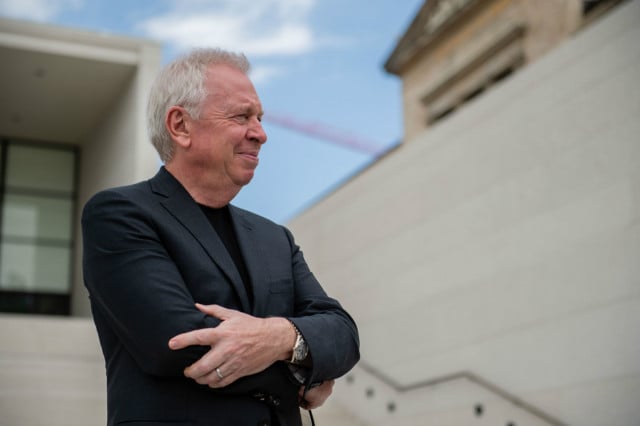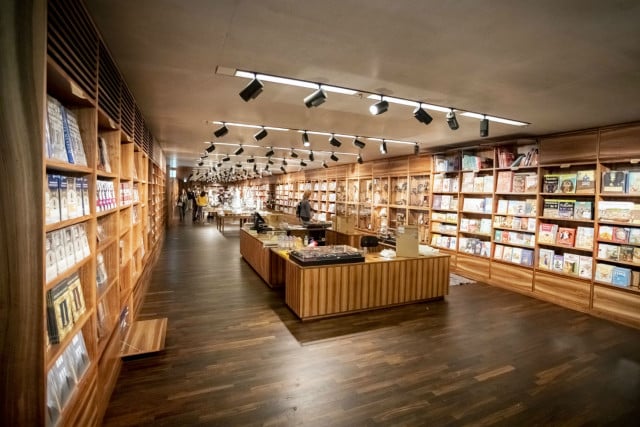Set to open its doors to the public on Saturday, July 13th, Berlin’s James Simon Gallery will act as a visitor centre to the UNESCO World Heritage Site and the collections housed within its five museums – the Bode, the Altes, the Neues and the Pergamon Museums as well as the Alte Nationalgalerie.
READ ALSO: Artists battle expulsions as rents spike in Berlin
Designed by star architect Sir David Chipperfield, the James Simon Gallery has been in the works for around 20 years. The building features an auditorium that can sit 300 people, special exhibition spaces, a permanent exhibition and media installations, a gift shop, a café and restaurant, various services like ticket counters and cloakrooms, and a terrace along the Kuperfgraben canal.
Described as a “linking infrastructure” by Chipperfield, the building will also provide the only entrance to the Pergamon Museum until renovations are complete there and offer a second entrance to the Neues Museum.
“It was not clear at the beginning what this building should be,” Chipperfield said on Wednesday. “It is clearly not another museum. It is an infrastructural building on one hand.
“It provides lots of facilities. But it is also a linking infrastructure. It connects the buildings together and provides orientation to the whole idea of Museum Island.”
READ ALSO: Inside Weimar's new politically charged museum
 Sir David Chipperfield outside the museum. Photo: DPA
Sir David Chipperfield outside the museum. Photo: DPA
The modern new building acts as a continuation of Museum Island structures. This is most clearly seen in the colonnade outside. The 19th-century colonnade, on which bullet scars from World War II are still clearly visible, originally ended at the Neues Museum. Chipperfield’s design has slimmer, sharper columns that meet the original ones, creating an interesting juxtaposition between history and the present.
The group of museums in the heart of Berlin attracts 2.5 million visitors a year.
Tributes paid to Jewish artists and patrons
The opening of the James Simon Gallery was described by museum officials in Berlin Wednesday as both a historical moment and important homage to one of the most important benefactors of the Staatliche Museen zu Berlin (Berlin State Museums).
James Simon, a Jewish businessman, philanthropist and art collector, donated approximately 10,000 items to Berlin Museums. One of his most famous donations is the Neferti bust. Sometimes dubbed Berlin’s Mona Lisa, the Nefertiti bust is housed in the Neues Museum. Simon also contributed funds that led to key excavations in the Middle East, such as that of the Ishtar Gate of Babylon, which is on display in the Pergamon Museum.
READ ALSO: Berlin inaugurates new Museum Island addition
Represented by Simon, the new visitor centre also pays tribute to other Jewish patrons and important members of Berlin society whose influence the Nazis tried to erase. “We want to do something to prevent us forgetting,” Hermann Parzinger, the president of the Preußicher Kulturbesitz, which oversees the city's museums, told reporters on Wednesday.
 Inside the gallery on Museum Island. Photo: DPA
Inside the gallery on Museum Island. Photo: DPA
One example of such a tribute is sculptor August Gaul’s “Reclining Lion” on display in the foyer. The statue was commissioned and owned by Jewish newspaper publisher and patron of the arts Rudolf Mosse in the early twentieth century. The statue survived World War II, stood for some time in the present Alte Nationalgalerie, and was restituted to the Lachmann-Mosse family in 2015 and reacquired by the Staatliche zu Museen in 2016.
Chancellor Angela Merkel is slated to officially open the building on Friday. On Saturday, the public will be able to walk through its doors and take part in a full-day of celebration and events.



 Please whitelist us to continue reading.
Please whitelist us to continue reading.
Member comments